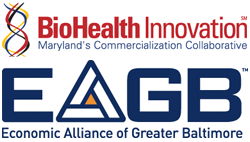
By Alissa Gulin, Daily Record Business Writer
A sizeable portion of a federal grant will go toward launching an intensive, 16-week accelerator program for health information technology entrepreneurs in Maryland.
Rich Bendis, president and CEO of BioHealth Innovation, said participants in the competitive program will come to Baltimore, meet with potential investors and partners and access the resources of Johns Hopkins Medicine, one of the partners in the accelerator. Officials will unveil more details of the program within a couple of weeks.
BioHealth Innovation, a Rockville-based group that acts as an intermediary between research institutions and the private sector, was one of two Maryland organizations that received a combined $520,000 grant, announced Wednesday, to help grow the state’s burgeoning biotechnology industry. The Economic Alliance of Greater Baltimore, an economic development group, was the other recipient.
Bendis’ organization will use the funding to help establish a “Healthcare Regional Innovation Cluster” — a network of people and partnerships focused on taking new medical technologies out of research labs and into the marketplace. The money probably won’t be invested in physical facilities; the cluster is “more of a virtual program” attempting to bring Maryland’s myriad assets in life sciences, health care and biotechnology together in a more meaningful way, Bendis said.
“It’s about creating that entrepreneurial culture and ecosystem that we need in Maryland, connecting people with new partnerships,” he said.
The award, from the Economic Development Administration within the U.S. Department of Commerce, is part of a broader federal strategy to boost national economic competitiveness. The EDA has invested about $200 million in similar “regional innovation clusters” in other states, based on their particular strengths, such as in advanced manufacturing or software development.
Funding from the EDA will help support many different components of the Healthcare Regional Innovation Cluster, said Bendis. He described the H-RIC as “an innovation ecosystem of interrelated resources that will work together to grow the innovation economy of the Baltimore region.”
Developing that ecosystem has been an ongoing endeavor in Maryland for years, but Bendis said those efforts need a boost.
That’s why BioHealth Innovation, which launched in January 2012, partnered with EAGB to identify regional needs and craft a proposal to the EDA seeking funding. They spent almost two years tweaking and resubmitting the proposal until it was approved on the third try, Bendis said.
“If you look at the [National Institutes of Health], Johns Hopkins University and [Johns Hopkins] Hospital, the University of Maryland … there are a lot of resources,” he said. “But there are these unconnected assets, and the question is, how do we get them to come together? So this grant is something that is strategic and incremental to the process. It will enable us to achieve our goals more quickly than if we did it without [the EDA’s] support.”
BHI primarily focuses on helping universities and hospitals in Baltimore County and the city commercialize research by forging ties with the bioscience industry and federal labs in Montgomery County.
The cluster’s ultimate objective is to generate more jobs in the health care and biotech industries, which are already crucial to the regional economy.
Over the past decade, Maryland’s life sciences sector has generated one-third of all job gains and now supports more than $9.6 billion in salaries for Marylanders, according to U.S. Rep. C.A. Dutch Ruppersberger, a Democrat whose district includes parts of Baltimore city and Anne Arundel, Howard, Harford and Baltimore counties.
“Medical research is our best hope for finding cures and improving treatment, but it’s also essential to Maryland’s economy,” Ruppersberger said in a statement. “This grant is a common sense public investment in jobs and community that will help even more Maryland families support themselves.”
Bendis said more money will be needed to develop a truly robust biotechnology ecosystem, and that BHI and EAGB are always looking for new partnerships and funding sources.
Bendis and his colleagues want to compile databases of useful information to help support people working in the biotech sectors. They might construct a “genealogy” of successful health and biotechnology companies that were born in Maryland — including how they started, who gave them funding, what their growth strategies were, what spinoff companies they produced and where they are now — as well as a map of Maryland’s assets, such as research labs, investment firms and business incubators.
Those tools would be motivating, Bendis said, and would show entrepreneurs what resources are available to help them grow.
“We are one of the leading research regions in the world, and now we’re starting to emphasize commercialization, like some other areas have already been doing,” he said. “I believe now there are more organizations and resources available, and momentum is really building, to grow the entrepreneurial culture in the Baltimore region. I think people are finally realizing that this is a high priority.”
Reprinted with permission from Alissa Gulin and TheDailyRecord.com
